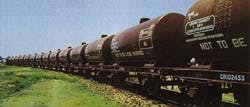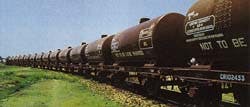Mohan Malhotra
Consultant
Orleans, Ont.
Railroad tank cars transport most of India's petroleum products, accounting for 40% of the market vs. 30% for pipelines. Photo courtesy of Indian Ministry of Petroleum and Natural Gas.India's petroleum transportation, distribution, and marketing infrastructure is poised for a massive expansion.
The combination of surging demand for oil-especially imports-fading regulatory and trade barriers, and an antiquated distribution infrastructure sets the stage for huge investments in pipelines, marine terminals, tankers, tank farms, and marketing outlets in India through the early part of the 20th century.
In some instances, the government of India has targeted private investment in these facilities through the introduction of fiscal incentives.
Indian petroleum demand
To meet India's projected demand for petroleum products early next century, officials estimate an investment of $100-150 billion will be required during the next 10-15 years.By the turn of the century, India will consume at least 700 million bbl/year (1.92 million b/d) of petroleum products. Wood Mackenzie, London, recently estimated Indian refined products demand at about 1.6 million b/d in 1998 (OGJ, Oct. 20, 1997, p. 31).
By 2010, India's refining capacity will have to expand to about 110 million metric tons/year (2.2 million b/d) for domestic use alone (excluding capacity dedicated to exports of refined products). As of Jan. 1, 1997, Oil & Gas Journal estimated Indian refining capacity at 1.086 million b/d.
In order to accommodate growth of this scope, a major expansion is called for in India's distribution infrastructure, especially cross-country pipe- lines, marine terminals, and tankage.
Another forecast of India's petroleum demand calls for 155 million tons/year, or 3.1 million b/d, by 2006-07.
Looking at the eighth 5-year plan (fiscal 1992-93 to 1996-97) the consumption of petroleum products in India grew at a rate of 7%/year. During the ninth fiscal year plan (1997-98 to 2002-03), assuming a gross domestic product growth rate of 7-8%/year, the consumption of petroleum products could increase by as much as 7-8%/ year.
With the progress of deregulation in the downstream sector, this situation affords excellent opportunities for investment by private companies, especially those based outside India.
Transportation status
In India, refined products and crude oil are transported by railways 40%, pipelines 30%, coastal tankers 12%, and roads 18%.In the case of rail transport, to avoid a shortage of broad-gauge tank cars, individual parties and oil companies are allowed to own tank cars. Indian railways will lease and operate the tank cars on their behalf.
At present, pipelines account for only a third of the total transportation capacity for petroleum crude and products. The government of India has recognized the need for the private sector to collaborate with the public sector and set up joint ventures in order to expand pipeline capacity.
At present there are eight major crude/product pipelines in the country with an aggregate length of 4,100 km and a combined capacity of 21 million tons/year (420,000 b/d).
About 13 pipeline projects have been identified for development by 2001-02 with a total length of 4,889 km and a capacity of 41.3 million tons/ year (846,000 b/d). These pipeline projects are listed in the table on this page.
In the petroleum storage sector, it has been estimated that, for the ninth fiscal year plan, about 13.8 million kl of additional tankage will be required for operating needs and a further 12.5 million kl as strategic cover.
The tankage can be developed and operated for the use of prospective marketing companies, including public sector companies.
Petroleum port facilities
India's port facilities will have to be expanded to facilitate the import of crude and petroleum products, and the government is taking steps to encourage investment in this area.At present there are 11 major ports and about 139 minor ports on India's west and east coasts and in the south (see map, this page). Some of the ports that handle crude and petroleum products include Kandla, Mumbai (Bombay), Cochin, Tuticorin, Chennai (Madras), Visakhapatnam, Haldia, and Paradip. New ports are being developed at Hazira, Kakinada, Neva Sheva, Ennore, and a few other locations. For the import of LPG, about 20 locations have been identified.
To handle the major expansion of India's port infrastructure, the government of India has opened up the sector to private participation in the following areas: leasing out port assets; creating additional facilities, such as container facilities and specialized cargo berths; and pilotage and captive facilities for port-based industries.
The government also has announced measures to promote foreign investment in the port sector. These include:
- Automatic approval of foreign equity of as much as 51% in projects related to support services for marine transportation operations, maintenance of piers, and the like.
- Automatic approval of foreign equity of as much as 74% in the construction and maintenance of ports and harbors.
- In some cases, foreign equity up to 100% that can be considered for port infrastructure.
Because of the urgent need for port facilities, the Secretary of India's Cabinet will monitor 12 projects currently under way at seven major ports. These projects include replacing subsea pipelines, modernization of the marine oil terminal berths at Mumbai (formerly Bombay), and creating crude and petroleum product facilities at New Mangalore.
Economic, fiscal environment
The political outlook for India in the short-term (1997-98) is expected to be both vigorous and volatile.There is a desire in the country to avoid new elections and try to maintain the 15-party coalition. GDP growth is expected to slow to 6.4% in 1997-98, but the growth is likely to accelerate to 7% in 1998-99.
This growth is possible because of expected tax cuts and lower interest rates.
Consumer price inflation was at 8.9% in 1996-97 and in the next 2 years is likely to average 8.5-9.5%.
India's industrial growth has suffered a setback recently, falling to an annual rate of 8% in fiscal 1996-97 from 11.7% in 1995-96.
The slowdown stemmed in large part from severe infrastructure bottlenecks caused by electricity shortages, port congestion, and poor roads.
New policy measures
India's government has implemented a number of new measures to attract more foreign capital and mobilize the strengths of the private sector, notably in the energy business.Repatriation of capital, along with capital appreciation after payment of taxes, is now permitted. This also applies to repatriation of sales proceeds, royalties, and technical know-how fees. In some cases, the prior approval of the Reserve Bank of India is required.
To attract foreign direct investment in India's underdeveloped infrastructure, certain sectors are designated as "core sectors." These sectors are then entitled to special incentives. In sectors such as power generation, oil and gas exploration and production, and refined products distribution, 100% foreign equity is allowed in certain cases.
In the case of ports, roads, and highways, foreign equity of 51% is permitted. In the case of petroleum refining, 26% of foreign equity is permitted.
Downstream opportunities
In the refining sector, there is need to add capacity and acquire technology to maximize the production of middle distillates.Capital costs in the refining/petrochemical sectors are low. For instance, a multi-feed ethylene cracker installed recently by an Indian company on the west coast of India (Hazira) cost about $800/ton, which is 36% lower than in the U.S. ($1,250/ton) and 47% cheaper than in Japan ($1,500/ton).
Similarly, employee costs are low; for an average Indian chemical company, employee costs are equal to 2% of sales. That compares with 29% for Germany's Hoechst AG and the 18% for U.K.'s ICI.
In the marketing sector, the import of petroleum products has been opened up to allow the import of LPG and kerosine.
Upstream incentives
India's government also continues to sweeten incentives for investment in the upstream oil and gas sector.Some of the important incentives offered to investors include:
- Year-round bidding for exploration acreage.
- An attractive fiscal regime for companies to share profits with the government.
- A 100% cost recovery mechanism.
- No up-front fees, such as signature bonuses and licensing fees.
- Deepwater exploration.
- Tapping the gas potential of the central onshore basins.
- Private participation through joint ventures with public companies.
- Acquiring foreign acreage and farmout opportunities.
- Dry hole expenses can be set off against revenue from commercial production in other fields.
- A 7-year tax holiday is given to fields located in Northeast India.
- Specific equipment imported for oil/gas exploration is exempt from customs duty.
- Non-resident oil companies en- gaged in petroleum exploration and production are taxed at 50%, as opposed to 55% in the case of other foreign companies.
- Oil and gas services are taxed at a deemed profit of 10% on gross revenue.
- No royalty payments, signature, or production bonus.
- No minimum expenditure commitment during the exploration period.
- Lease periods for crude oil, 25 years; natural gas, 35 years.
- A maximum exploration period of 7 years.
- Linking profit-sharing terms for oil and gas production to post-tax profitability.
- The government of India retains first option to purchase up to 100% of the crude oil produced at international market prices.
- Exemption from custom duties on all project related imports.
- Corporate income tax at 50% for overseas companies.
- Free repatriation of funds.
- Create a framework for transparency of transactions.
- Establish an "empowered negotiating committee" to fast-track decisions.
- Restructure state-owned enterprises.
- Phase out the Administered Price Mechanism (in the first week of September 1997, the first phase was implemented).
- Grant a tax holiday for 10 years after commencement of commercial production.
Capital markets
The well-developed banking system in India is supervised by the Reserve Bank of India.There are 78 designated commercial banks (including 31 foreign banks), 196 regional rural banks, and a supporting network of financial institutions.
The stock markets in India are regulated by the Securities and Exchange Board of India (SEBI). With over 20 million shareholders, India has the third largest investor base in the world, following the U.S. and Japan.
India's stock market capitalization at yearend 1995 was $135 billion. This compares with other developing countries such as Malaysia $210 billion, Mexico $95 billion, and China $47 billion.
India has been looking for private investors in its financial services sector, with the latest major entrant the Bank of America (BOA) in August 1997. BOA plans to invest $100 million primarily in unlisted Indian companies over the next few years.
Other new investors are George Soros, Chase Manhattan Corp., Oppenheimer, and Capital LP, among others, which have committed more than $400 million to finance aggressive growth in Indian business.
Some international fund managers say that India has everything: private equity, investor desire, an established stock market, a strong entrepreneurial culture, demand for capital, and a large English-speaking population.
At the Asia-Pacific Economic Cooperation Conference in August 1997, various officials predicted that, over the next 15 years, the Asia-Pacific region would require an investment of about $1.6 trillion in energy infrastructure-including pipelines, refineries, and power plants.
To promote private investors to invest in India's energy infrastructure, the government will have to compete in the world market in providing adequate financial incentives, a risk-free environment, and rapid project approval.
Copyright 1997 Oil & Gas Journal. All Rights Reserved.



